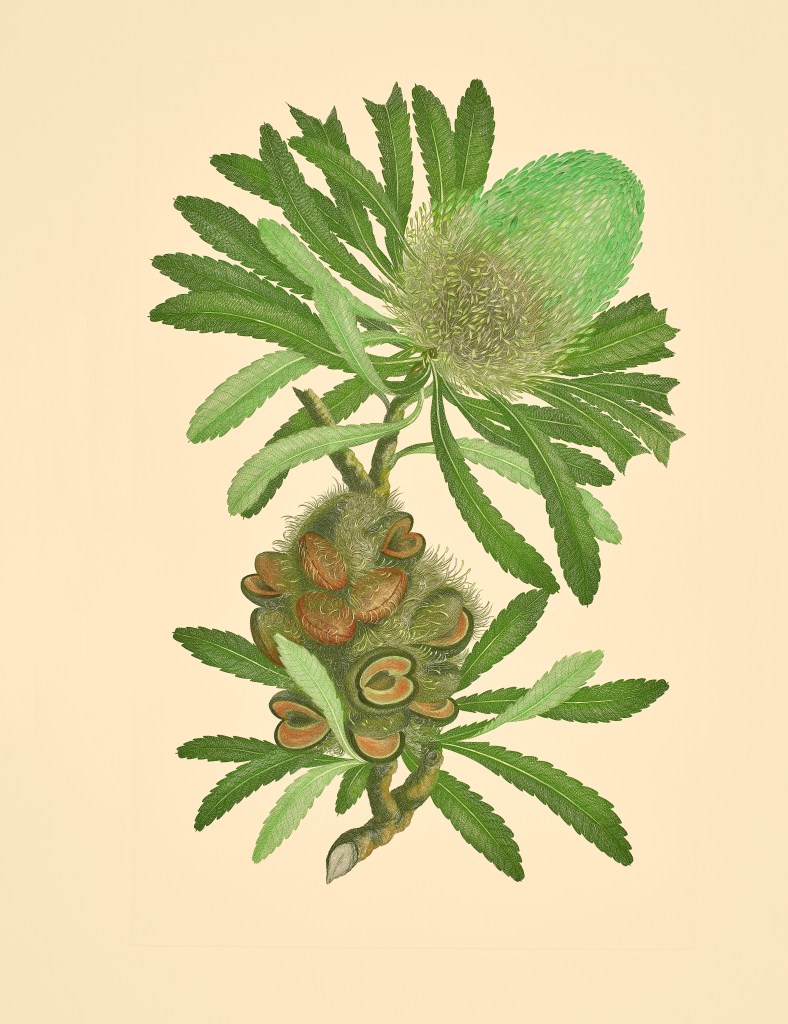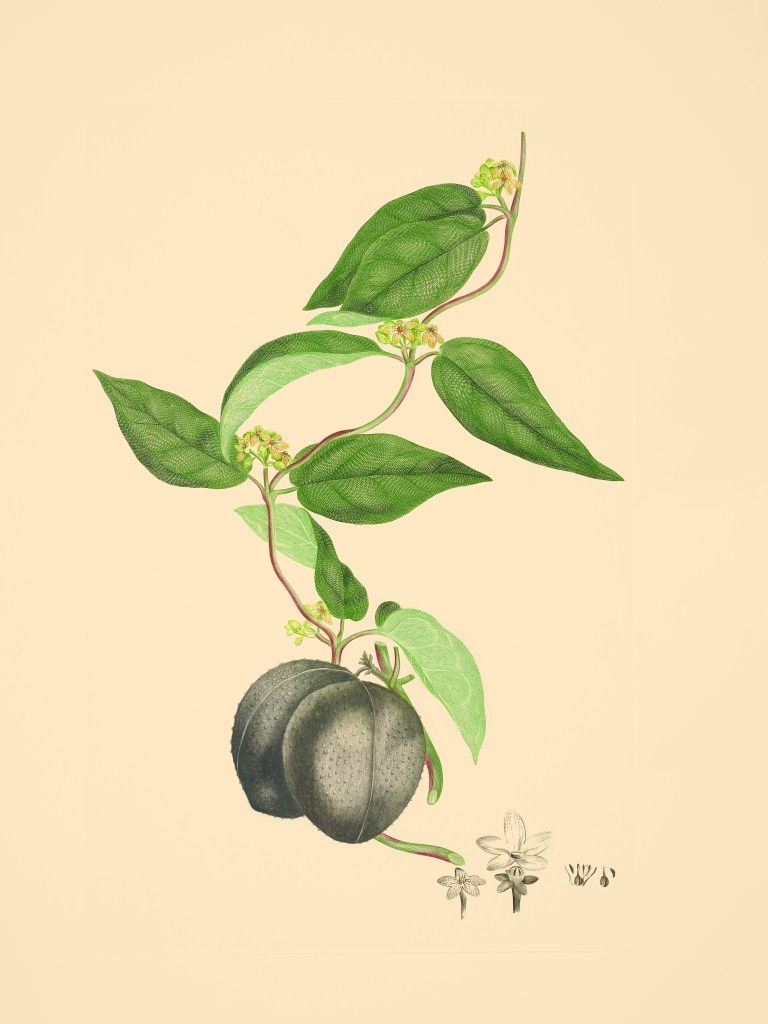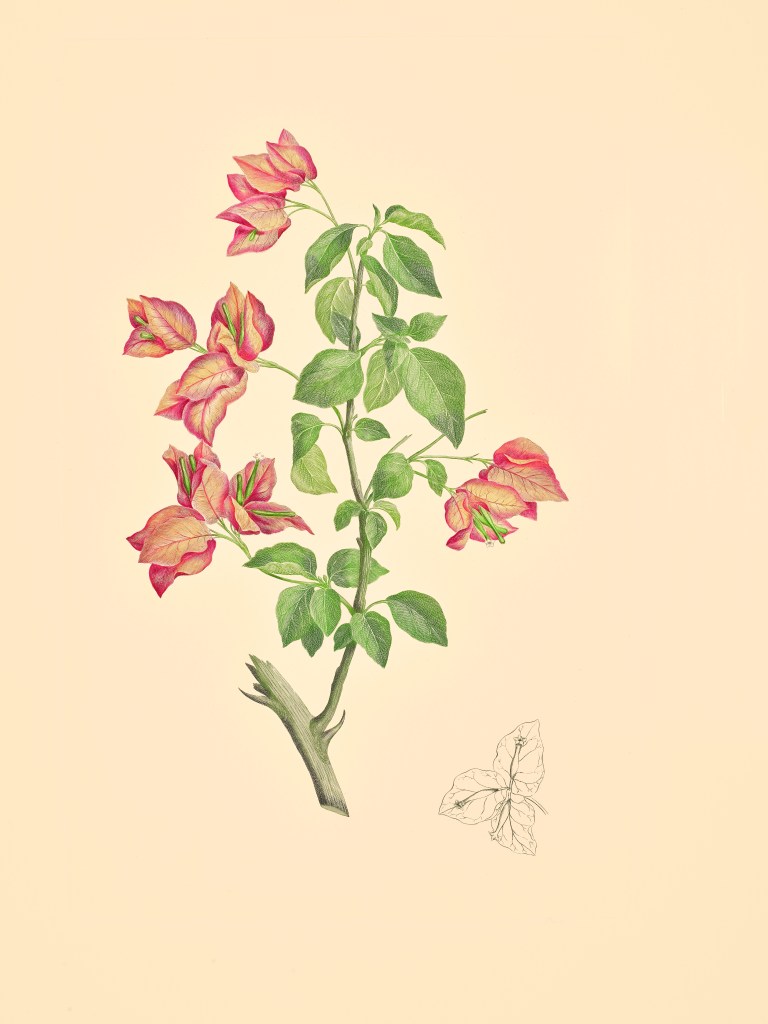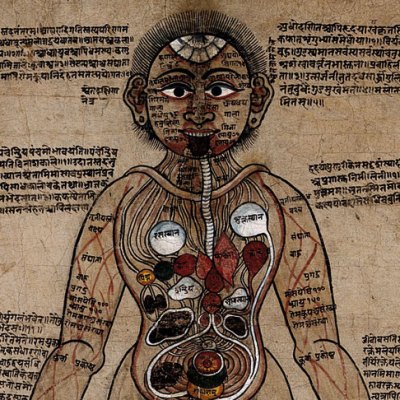On 25 August 1768, the Endeavour set sail from Plymouth under the command of Lieutenant James Cook, officially to observe the transit of Venus in June 1769 from Otahite (Tahiti) but secretly, on the instructions of the Admiralty, to find the Southern Continent and to record its topography, soil, fauna, flora, and minerals. On board was the 25-year-old botanist, Joseph Banks, accompanied by a small team including a Swedish botanist, Dr Daniel Solander, a pupil of Linnaeus, and a Scottish botanical artist, Sydney Parkinson. They took a library of natural history books including Linnaeus’s Systema Naturae and Species Plantarum and ‘machines for catching and preserving insects; all kinds of nets, trawls, drags, and hooks for coral fishing […] They have many cases of bottles with ground stoppers, of several sizes, to preserve animals in spirits […] several sorts of salts to surround the seeds; and wax’.
 Banks funded this part of the expedition himself; it was the first to focus on scientific and cartographic exploration and accurately recorded by artists. Banks also employed Alexander Buchan as a ‘landscape and figure painter’, whose death at sea in 1769 Banks lamented: ‘my airy dreams of entertaining my friends in England with the scenes that I am to see here have vanished.’ Of the 94 men who had sailed, 38 died during the voyage including the astronomer and all the artists.
Banks funded this part of the expedition himself; it was the first to focus on scientific and cartographic exploration and accurately recorded by artists. Banks also employed Alexander Buchan as a ‘landscape and figure painter’, whose death at sea in 1769 Banks lamented: ‘my airy dreams of entertaining my friends in England with the scenes that I am to see here have vanished.’ Of the 94 men who had sailed, 38 died during the voyage including the astronomer and all the artists.
Banks had been a passionate botanist since childhood and on inheriting a large fortune in 1764 he began using his wealth and knowledge for scientific pursuits. He rejected the standard Grand Tour of classical Italy: ‘Every blockhead does that; My grand tour shall be one round the whole globe.’ He had already travelled to Newfoundland in 1766 and on hearing of Cook’s expedition he applied to the Royal Society to join it.
(1772–84), Gabriel Smith after Sydney Parkinson and John Frederick Miller. © Editions Alecto and the Trustees of the Natural History Museum, London

The perilous voyage circumnavigated the globe from east to west, making landfall at Madeira, Brazil, Tierra del Fuego, the Society Islands, New Zealand, Australia, and Java. The scientific work continued at sea, resulting in a Flora for each of the lands he visited with coastal charts, and observations on anthropology and topography. The scale of the exercise of collecting, storing, preserving, and recording the specimens in written and drawn form while at sea was immense. The drawings – often the first precise drawings of the plants in question – were and are of the greatest scientific interest, and they serve as a record not only of the plants newly discovered and introduced to Europe, but also of the indigenous species of Australia and New Zealand before European plants were introduced there.
The Endeavour landed at Deal on 12 July 1771 with around 30,000 plant specimens (approximately 110 new genera and 1,300 new species) and 955 of Parkinson’s drawings (not all of them finished), made before his death at sea. The botanical findings were intended for publication. Solander prepared the text and a team of artists and engravers were employed to complete 863 drawings and 743 plates, closely supervised by Banks. Had he published his Florilegium it would have been the most detailed British study of botany of the 18th century. His failure to do so remains a mystery. He made his work and collections available to scholars at his home and dispersed other material. Prints were published sporadically, but it was not until the 1960s that the idea of publishing all of them took root. This was not achieved until 1990 when Alecto Historical Editions produced the final part from the original copper plates in full-colour, as a limited edition of 100, under the title Banks’ Florilegium.
Sarcolobus globosus (1772–84), Gabriel Smith after John Frederick Miller. Natural History Museum, London © Editions Alecto and the Trustees of the Natural History Museum, London

Thames & Hudson’s splendid new publication is based on a selection of those plates, here reproduced at 75 per cent of their original size and chosen for their artistic beauty or botanical interest. The colour plates are the main body of the book, arranged chronologically by the places visited, with David Mabberley’s scholarly introduction to them and his accompanying commentaries.
Mabberley’s account of the plants includes fascinating details. Bougainvillea spectabilis, collected in Rio de Janeiro in 1768, has significant antibacterial and antiviral properties; Lepidium oleraceum, collected in New Zealand in 1769, is a rich source of vitamin C and was eaten by Cook’s crew to prevent scurvy; Tetragonia tetragonioides is grown as a spinach substitute in areas too hot for Spinacia oleracea and was eaten by Banks with stingray and tripe; Banksia serrata, a tree growing up to 16 metres in height, is one of four species of a new genus found by Banks; Sarcolobus globosus, collected in Java in 1771, was one of the last plants drawn by Parkinson and has poisonous seeds that may have killed off the Javan tigers, but is used locally as an antimalarial.
Bougainvillea spectabilis (1772–84), Gabriel Smith after Sydney Parkinson. Natural History Museum, London. © Editions Alecto and the Trustees of the Natural History Museum

The two-part supporting text by the art historian Mel Gooding covers the history of the voyage from 1768–71 and the subsequent history of the Florilegium from 1772–1990, with detailed information on the artists and their work on the finished drawings. He points the contrast between the earlier plates by Parkinson and the richer ones made in the South Seas, which match the richness of the life that he witnessed in Tahiti. Gooding also provides insight into the scientific and ethnological exploits in his fluent text. The delayed publication of the Florilegium meant that many of the plants that should have been named in Banks’s honour were named after botanists who found the plants at a later date. An afterword by Joe Studholme describes the history and process of the modern printing of Banks’ Florilegium by Alecto Historical Editions. A map of the journey is helpfully provided in the endpapers.
The text and commentaries are well-researched and the cross-referencing, taxonomy, and nomenclature will ensure that it is of use to specialists, but there is also much to enjoy for the general reader with an interest in botany, botanical art, 18th-century history, and scientific discovery in the Age of Enlightenment.
Joseph Banks’ Florilegium: Botanical Treasures from Cook’s First Voyage by Mel Gooding, David Mabberley, and Joe Studholme (Thames & Hudson)
From the November issue of Apollo. Preview and subscribe here.



